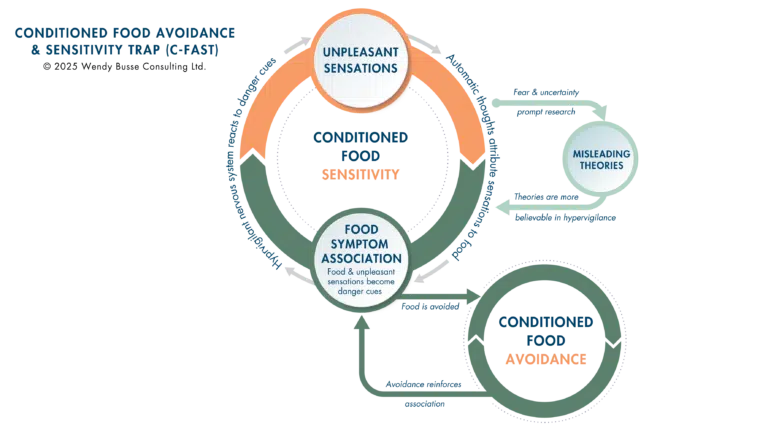- Are you tired of not knowing what foods will make you feel sick?
- Is your list of “safe” foods getting smaller, but your symptoms don’t seem to be getting better?
- Have you tried all the elimination diets, but you still don’t have clarity on your triggers?
Navigating life with IBS can feel like walking a tightrope between enjoying food and avoiding discomfort. For many, this delicate balance leads to a complex relationship with food, where certain foods become synonymous with symptoms. In some cases, this is accurate. However, in other cases, the body can associate incorrectly, and conditioned food sensitivities can develop. Conditioned food avoidance and sensitivity (C-FAST) is debilitating and can significantly impact a person’s quality of life.
What is Conditioned Food Avoidance?
Conditioned food avoidance occurs when individuals associate specific foods with negative experiences, such as pain or gastrointestinal distress. For example, if someone has severe bloating after eating bread, the body may associate bread with bloating (a food-symptom association). This signals the brain to avoid bread in an attempt to prevent discomfort.
Conditioned Food Avoidance describes diet restrictions driven by food-symptom associations. The associations can be:
Accurate: leading to a beneficial restriction (i.e., a biological-in-origin food reaction)
Inaccurate: leading to excess restriction.
What is Conditioned Food Sensitivity
While food allergies and intolerances have biological causes, conditioned food sensitivity is a learned reaction of the body and brain. The communication network between the digestive system and the brain (the gut-brain axis), plays a key role in this process. Food-Symptom associations can become so ingrained that eating (or the mere thought of eating) these foods triggers anxiety and a conditioned reaction.
This reaction can manifest as a range of symptoms, from bloating and cramping to nausea and changes in bowel habits. Importantly, these symptoms can occur without an underlying biological cause. It’s the body’s way of saying, “I’ve been here before, and it didn’t go well,” regardless of whether the food is truly harmful.
Conditioned Food Sensitivity is a food reaction driven by inaccurate food-symptom associations. In other words, fear and negative expectations create or intensify unpleasant sensations.
Conditioned Food Avoidance and Sensitivity Trap (C-FAST)
Wendy Busse, MSc, RD, developed the C-FAST model to explain the vicious cycle of dietary restriction and worsening symptoms. With restriction, a person’s diet becomes limited, potentially leading to nutritional deficiencies and a heightened sensitivity to a broader range of foods. The more foods are avoided, the more the body reinforces the belief that these foods are dangerous, further intensifying the fear and physical reactions associated with eating.
This cycle can have a profound psychological impact, as individuals become increasingly anxious about food choices and the potential for symptoms. The anticipation of discomfort can trigger symptoms, making it difficult to break free from the cycle.

The Conditioned Food Avoidance & Sensitivity Trap (C-FAST) can devastate your physical and mental health, making you feel:
- Frustrated: by an endless cycle of elimination diets.
- Hopeless: that you will be on a restricted diet forever.
- Scared: to eat.
- Angry: that you cannot enjoy food like other people.
- Alone: because your restricted diet makes socialising difficult.
- Exhausted: because your life revolves around food.
- Confused: about what you should and should not eat.
- Worried: that you are not getting adequate nutrition.
Interventions and Management Strategies
Managing conditioned food sensitivity involves a combination of dietary and behavioural interventions. The first step in addressing C-FAST is to retrain your gut-brain connection so that your body no longer associates certain foods with danger. The key to success is preparing your nervous system and gut to respond differently before reintroducing foods into your diet.
- What would your life be like if food was a source of pleasure and joy instead of anxiety?
- What if your list of foods was expanding instead of shrinking?
If you’re ready to break free from the C-FAST cycle, it’s time to put the groundwork in place so you can successfully reintroduce foods.
Booking a consultation with me will help you assess your specific situation and create a personalized plan to retrain your gut-brain axis, address your food sensitivities, and start reintroducing foods in a safe and sustainable way.
👉 Book a consultation with me today to get started on your journey toward a more balanced and enjoyable relationship with food.
Conclusion
Conditioned food avoidance and sensitivity are complex issues requiring a nuanced management approach. By understanding the nature of these reactions and incorporating both dietary and behavioural strategies, you can regain a more balanced and enjoyable relationship with food. If you or someone you know may be struggling with conditioned food reactions, consider seeking professional support to address these challenges and begin the journey toward a more varied and fulfilling diet.







